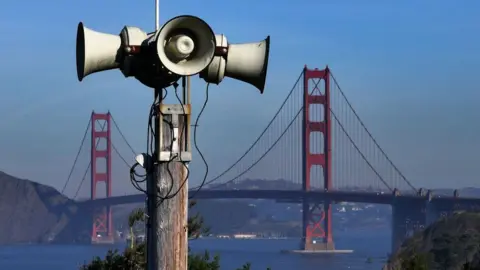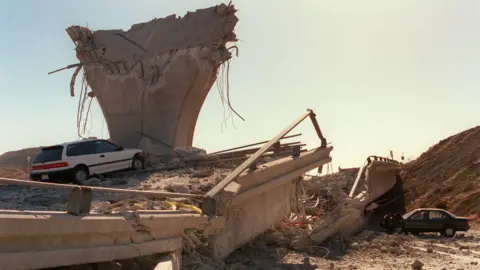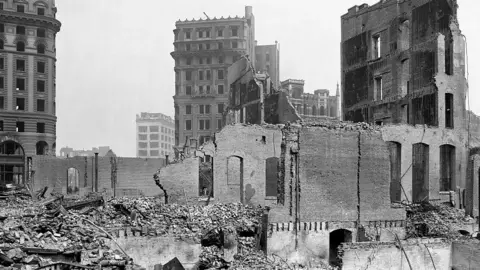BBC Information, Washington DC
BBC Information, Los Angeles
BBC Information, Seattle
 Getty Photographs
Getty PhotographsBrent Dmitruk calls himself an earthquake predictor.
In mid-October, he informed his tens of hundreds of social media followers that an earthquake would quickly hit on the westernmost level of California, south of the small coastal metropolis of Eureka.
Two months later, a magnitude 7.3 struck the location in northern California – placing thousands and thousands beneath a tsunami warning and rising Mr Dmitruk’s following on-line as they turned to him to forecast the following one.
“So to individuals who dismiss what I do, how are you going to argue it is only a coincidence. It requires critical ability to determine the place earthquakes will go,” he stated on New Years Eve.
However there’s one downside: earthquakes cannot be predicted, scientists who examine them say.
And it is precisely that unpredictability that makes them so unsettling. Hundreds of thousands of individuals dwelling on the west coast of North America worry that “the massive one” might strike at any second, altering landscapes and numerous lives.
 Getty Photographs
Getty PhotographsLucy Jones, a seismologist who labored for the US Geological Survey (USGS) for greater than three many years and authored a ebook known as The Massive Ones, has targeted a lot of her analysis on earthquake chances and bettering resiliency to resist such cataclysmic occasions.
For so long as she has studied earthquakes, Ms Jones stated there have been individuals wanting a solution to when “the massive one” – which implies various things in numerous areas – will occur and claiming to have cracked the code.
“The human must make a sample within the face of hazard is extraordinarily robust, it’s a very regular human response to being afraid,” she informed the BBC. “It does not have any predictive energy, although.”
With some 100,000 earthquakes felt worldwide every year, in keeping with the US Geological Survey (USGS), it’s comprehensible that folks need to have warning.
The Eureka space – a coastal metropolis 270 miles (434km) north of San Francisco, the place December’s earthquake occurred, has felt greater than 700 earthquakes throughout the final yr alone – together with greater than 10 in simply the final week, knowledge reveals.
The area, which is the place Mr Dmitruk guessed appropriately {that a} quake would happen, is likely one of the most “seismically lively areas” of the US, in keeping with the USGS. Its volatility is because of three tectonic plates assembly, an space generally known as the Mendocino Triple Junction.
It’s the motion of plates in relation to one another – whether or not above, beneath or alongside – that causes stress to construct up. When the stress is launched, an earthquake can happen.
Guessing that an earthquake would occur right here is a straightforward guess, Ms Jones stated, though a robust magnitude seven is sort of uncommon.
The USGS notes there have been solely 11 such quakes or stronger since 1900. 5, together with the one Mr Dmitruk promoted on social media, occurred in that very same area.
Whereas the guess was appropriate, Ms Jones informed the BBC that it is unlikely any earthquake – together with the biggest, society-destroying sorts – will ever have the ability to be forecasted with any accuracy.
There’s a advanced and “dynamic” set of geological elements that result in an earthquake, Ms Jones stated.
The magnitude of an earthquake is probably going shaped because the occasion is going on, she stated, utilizing ripping a bit of paper as an analogy: the rip will proceed until there’s one thing that stops it or slows it – similar to a water marks that depart the paper moist.
Scientists know why an earthquake happens – sudden actions alongside fault strains – however predicting such an occasion is one thing the USGS says can’t be accomplished and one thing “we don’t count on to understand how any time within the foreseeable future”.
 Getty Photographs
Getty PhotographsThe company notes it might calculate earthquake chance in a selected area inside a sure variety of years – however that is as shut as they will come.
Geological information present that a few of the largest forms of earthquakes, generally known as “the massive one” to locals, do occur with some quantity of regularity. The Cascadia subduction zone is thought to slide each 300 to 500 years, commonly upending the Pacific northwestern coast with 100-ft (30.5 metres) tall mega-tsunamis.
Whereas the San Andreas fault in Southern California can be the supply of one other potential “massive one”, with bone-rattling earthquakes taking place there each 200-300 years. Consultants have stated the “massive one” might occur at any second in both area.
Ms Jones says over her profession, she’s had a number of thousand individuals alert her to such predictions of an enormous earthquake – together with individuals within the Nineteen Nineties who would ship faxes to her workplace in hopes of alerting them.
“While you get a prediction each week, any individual’s going to be fortunate, proper?” she says with amusing. “However then that often would go to their head they usually predicted 10 extra that weren’t proper.”
Such a situation seems to have occurred with Mr Dmitruk, who has no science background. He has lengthy predicted an extremely giant 10.3 quake would strike southwest Alaska or islands off the coast of New Zealand, a magnitude so robust he stated it might disrupt international commerce.
The USGS says an earthquake prediction should have three outlined parts – a date and time, the placement of the earthquake and the magnitude – in an effort to be of any use.
However Mr Dmitruk’s timeline retains shifting.
At one level, he stated it might come instantly earlier than or after the inauguration of US President Donald Trump.
Then he stated it might positively occur earlier than 2030.
Whereas that sizeable quake has but to strike, Mr Dmitruk stated he nonetheless believes the it is going to happen.
“I do not consider it is simply by probability,” Mr Dmitruk informed the BBC. “It isn’t random or luck.”
This kind of considering is frequent with regards to earthquakes, Ms Jones stated.
“Random distributions can appear like they’ve patterns, we see constellations within the stars,” she stated.
“Lots of people are actually afraid of earthquakes, and the best way to take care of it’s to foretell [when] it is going to occur.”
How one can put together for the uncertainty of a quake
However simply since you can not predict when an earthquake will strike doesn’t suggest it’s important to be unprepared, specialists stated.
Every year, on the third Thursday in October, thousands and thousands of People take part within the largest earthquake drill on earth: The Nice Shake Out.
It was created by a gaggle on the Southern California Earthquake Heart, which included Ms Jones.
In the course of the drill, individuals practise the steering of Drop, Cowl, and Maintain On: they drop to their knees, take cowl beneath a sturdy object like a desk, and maintain on for one minute.
The drill has change into so common since its inception that it has unfold up the earthquake-prone coast to different states and international locations.
If outside, persons are suggested to get to an open house away from timber, buildings or power-lines. Close to the ocean, individuals practise fleeing to larger floor after the shaking stops to arrange for the opportunity of a tsunami.
“Now, whereas the bottom just isn’t shaking, whereas it isn’t a really annoying scenario, is admittedly the perfect time to practise,” stated Brian Terbush, the Earthquake and Volcano Program Supervisor for the Washington state Emergency Administration Division.
Aside from the drills, residents of West Coast states use a telephone alert system maintained by USGS known as ShakeAlert.
The system works by detecting strain waves emitted by an earthquake. Whereas it might’t predict when an earthquake will occur within the distant future, it does give seconds of warning that could possibly be life-saving. It’s the closest factor to an earthquake “predictor” that has been invented to this point.
BBC Information, Washington DC
BBC Information, Los Angeles
BBC Information, Seattle
 Getty Photographs
Getty PhotographsBrent Dmitruk calls himself an earthquake predictor.
In mid-October, he informed his tens of hundreds of social media followers that an earthquake would quickly hit on the westernmost level of California, south of the small coastal metropolis of Eureka.
Two months later, a magnitude 7.3 struck the location in northern California – placing thousands and thousands beneath a tsunami warning and rising Mr Dmitruk’s following on-line as they turned to him to forecast the following one.
“So to individuals who dismiss what I do, how are you going to argue it is only a coincidence. It requires critical ability to determine the place earthquakes will go,” he stated on New Years Eve.
However there’s one downside: earthquakes cannot be predicted, scientists who examine them say.
And it is precisely that unpredictability that makes them so unsettling. Hundreds of thousands of individuals dwelling on the west coast of North America worry that “the massive one” might strike at any second, altering landscapes and numerous lives.
 Getty Photographs
Getty PhotographsLucy Jones, a seismologist who labored for the US Geological Survey (USGS) for greater than three many years and authored a ebook known as The Massive Ones, has targeted a lot of her analysis on earthquake chances and bettering resiliency to resist such cataclysmic occasions.
For so long as she has studied earthquakes, Ms Jones stated there have been individuals wanting a solution to when “the massive one” – which implies various things in numerous areas – will occur and claiming to have cracked the code.
“The human must make a sample within the face of hazard is extraordinarily robust, it’s a very regular human response to being afraid,” she informed the BBC. “It does not have any predictive energy, although.”
With some 100,000 earthquakes felt worldwide every year, in keeping with the US Geological Survey (USGS), it’s comprehensible that folks need to have warning.
The Eureka space – a coastal metropolis 270 miles (434km) north of San Francisco, the place December’s earthquake occurred, has felt greater than 700 earthquakes throughout the final yr alone – together with greater than 10 in simply the final week, knowledge reveals.
The area, which is the place Mr Dmitruk guessed appropriately {that a} quake would happen, is likely one of the most “seismically lively areas” of the US, in keeping with the USGS. Its volatility is because of three tectonic plates assembly, an space generally known as the Mendocino Triple Junction.
It’s the motion of plates in relation to one another – whether or not above, beneath or alongside – that causes stress to construct up. When the stress is launched, an earthquake can happen.
Guessing that an earthquake would occur right here is a straightforward guess, Ms Jones stated, though a robust magnitude seven is sort of uncommon.
The USGS notes there have been solely 11 such quakes or stronger since 1900. 5, together with the one Mr Dmitruk promoted on social media, occurred in that very same area.
Whereas the guess was appropriate, Ms Jones informed the BBC that it is unlikely any earthquake – together with the biggest, society-destroying sorts – will ever have the ability to be forecasted with any accuracy.
There’s a advanced and “dynamic” set of geological elements that result in an earthquake, Ms Jones stated.
The magnitude of an earthquake is probably going shaped because the occasion is going on, she stated, utilizing ripping a bit of paper as an analogy: the rip will proceed until there’s one thing that stops it or slows it – similar to a water marks that depart the paper moist.
Scientists know why an earthquake happens – sudden actions alongside fault strains – however predicting such an occasion is one thing the USGS says can’t be accomplished and one thing “we don’t count on to understand how any time within the foreseeable future”.
 Getty Photographs
Getty PhotographsThe company notes it might calculate earthquake chance in a selected area inside a sure variety of years – however that is as shut as they will come.
Geological information present that a few of the largest forms of earthquakes, generally known as “the massive one” to locals, do occur with some quantity of regularity. The Cascadia subduction zone is thought to slide each 300 to 500 years, commonly upending the Pacific northwestern coast with 100-ft (30.5 metres) tall mega-tsunamis.
Whereas the San Andreas fault in Southern California can be the supply of one other potential “massive one”, with bone-rattling earthquakes taking place there each 200-300 years. Consultants have stated the “massive one” might occur at any second in both area.
Ms Jones says over her profession, she’s had a number of thousand individuals alert her to such predictions of an enormous earthquake – together with individuals within the Nineteen Nineties who would ship faxes to her workplace in hopes of alerting them.
“While you get a prediction each week, any individual’s going to be fortunate, proper?” she says with amusing. “However then that often would go to their head they usually predicted 10 extra that weren’t proper.”
Such a situation seems to have occurred with Mr Dmitruk, who has no science background. He has lengthy predicted an extremely giant 10.3 quake would strike southwest Alaska or islands off the coast of New Zealand, a magnitude so robust he stated it might disrupt international commerce.
The USGS says an earthquake prediction should have three outlined parts – a date and time, the placement of the earthquake and the magnitude – in an effort to be of any use.
However Mr Dmitruk’s timeline retains shifting.
At one level, he stated it might come instantly earlier than or after the inauguration of US President Donald Trump.
Then he stated it might positively occur earlier than 2030.
Whereas that sizeable quake has but to strike, Mr Dmitruk stated he nonetheless believes the it is going to happen.
“I do not consider it is simply by probability,” Mr Dmitruk informed the BBC. “It isn’t random or luck.”
This kind of considering is frequent with regards to earthquakes, Ms Jones stated.
“Random distributions can appear like they’ve patterns, we see constellations within the stars,” she stated.
“Lots of people are actually afraid of earthquakes, and the best way to take care of it’s to foretell [when] it is going to occur.”
How one can put together for the uncertainty of a quake
However simply since you can not predict when an earthquake will strike doesn’t suggest it’s important to be unprepared, specialists stated.
Every year, on the third Thursday in October, thousands and thousands of People take part within the largest earthquake drill on earth: The Nice Shake Out.
It was created by a gaggle on the Southern California Earthquake Heart, which included Ms Jones.
In the course of the drill, individuals practise the steering of Drop, Cowl, and Maintain On: they drop to their knees, take cowl beneath a sturdy object like a desk, and maintain on for one minute.
The drill has change into so common since its inception that it has unfold up the earthquake-prone coast to different states and international locations.
If outside, persons are suggested to get to an open house away from timber, buildings or power-lines. Close to the ocean, individuals practise fleeing to larger floor after the shaking stops to arrange for the opportunity of a tsunami.
“Now, whereas the bottom just isn’t shaking, whereas it isn’t a really annoying scenario, is admittedly the perfect time to practise,” stated Brian Terbush, the Earthquake and Volcano Program Supervisor for the Washington state Emergency Administration Division.
Aside from the drills, residents of West Coast states use a telephone alert system maintained by USGS known as ShakeAlert.
The system works by detecting strain waves emitted by an earthquake. Whereas it might’t predict when an earthquake will occur within the distant future, it does give seconds of warning that could possibly be life-saving. It’s the closest factor to an earthquake “predictor” that has been invented to this point.











